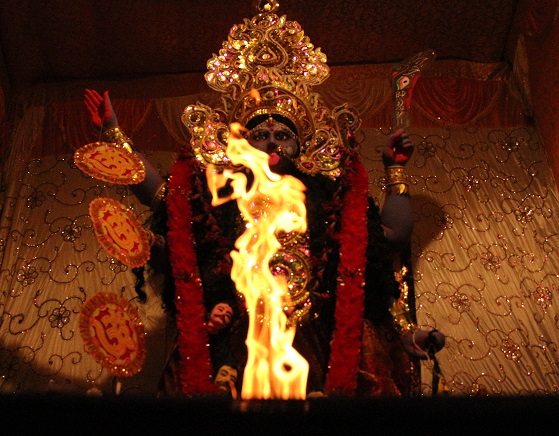In Praise of Darkness: Reclaiming Our Relationship with the Dark Mother.

Once upon a time, I was afraid of the dark.
When I first began meditating, it frustrated me that there was nowhere in my house that felt truly private. The only option was a small patio off of my bedroom, but I had a problem: I liked to meditate early in the morning, often before the sun was up, and I couldn’t imagine sitting outside in the dark. Who knew what kind of creatures were out there?
I had no other good choices. So I started slow — first by sitting in the doorway, then gradually making my way outside, with lights on inside the house to illuminate the outdoors. My husband helped me hang a string of bulbs around the outside, which provided soft lighting, and I began turning off the lights inside. Slowly, I became more comfortable with less light.
One day I realized I didn’t need the lights at all. My eyes would adjust to the dark, and it was a quiet gift to open my eyes at the end of meditation and see how the world had changed.
I find myself craving that darkness now. Some of my most peaceful moments have been spent sitting outside alone in the dark, the silence being broken only by the hoot of an owl, or the yip of a coyote off in the distance.
“We come from the dark, and we return to the dark,” writes Clark Strand in his beautiful book Waking Up to the Dark. “We are not merely in it, but of it. The darkness does our thinking when we let it, and it is the darkness in which we move.”
Why, then, do we fear darkness? And has it always been so?
Strand recounts a sleep study that was conducted by the National Institute of Medicine in the 1990s. The purpose was to evaluate how humans would sleep without access to modern lighting, in the hopes that it would provide insight into how our ancestors may have once slept.
For one month, study participants were removed from all forms of artificial light between dawn and dusk. And for the first three weeks, it was pretty much business as usual. Participants slept the same as they always did, except for an hour or so longer.
On the fourth week, everything changed. Participants began sleeping for about four hours at the beginning of the night, followed by two hours of wakefulness, dubbed “quiet rest” by the researchers. Another four hours of sleep followed.
What was happening during those two hours of “quiet rest,” where participants lay awake in the dark? Researchers compared it to a state between sleep and wakefulness, “a state of consciousness all of its own.” The closest thing it resembled was a state of meditation achieved by long-term practitioners.
As it turns out, this period of quiet rest in the middle of the night was probably practiced by our ancestors for thousands of years. And it served a purpose beyond rest: “In every religion there is a long-established tradition, usually initiated by its founder, that involves waking up in the middle of the night for some spiritual practice — for meditation, chanting, or for prayer,” writes Strand.
Darkness as a pathway to the sacred. What a beautiful, mystical idea — but one that is mostly foreign to the way we live now.
In the first few paragraphs of the Bible, God’s second act, after creating light, was to separate it from the darkness. He proclaims the light to be good; he makes no comment on the dark. But we all know the evils that lurk there.
Most of our mythical and threatening beasts are hiding in wait for us in the dark — vampires, werewolves, witches, even chainsaw-wielding psychopaths. Darkness, too, is the home of the dead, whom we also fear. Hell and the Underworld are far beneath our feet, deep in the darkness of the earth — places no one wants to go.
It hasn’t always been this way. Long ago, our ancestors once knew God as Goddess, and they experienced darkness differently. They oriented their lives to the moon, and they knew that the darkness of the new moon was the totality which gives rise to all its other phases. They also knew that the darkness was the womb of the Great Mother Herself — the void out of which all life emerges, and to which all life returns.
Over time, this view of darkness shifted. In their book The Myth of the Goddess, Anne Baring and Jules Cashford write that beginning in the Bronze Age, around 2500 BCE, death came to be seen as “an absolute end and the opposite of life.” And by the Iron Age, beginning around 1200 BCE, this viewpoint had solidified the notion of darkness as “bad.”
“Blackness is an image that was always associated with the Great Goddess,” write Baring and Cashford. “It symbolized the ineffable wisdom and mystery of life and its power to regenerate itself. But during the Iron Age, as the goddess was replaced by the god, blackness came to be a symbol of darkness in the sense of evil.”
We can still find the Dark Mother in Goddess-worshiping traditions spanning both time and geography. The wondrous Kali, Hindu Goddess of creation, destruction and shadow, is often depicted with black as well as blue skin. The Buddhist Goddess Tara, in her Black form, is associated with power. Isis, the Egyptian Goddess of Heaven, Earth and the Underworld, is frequently depicted with dark skin.
Some of the most haunting images are those of the Black Madonnas, the paintings and statues found all over Europe that depict the Virgin Mary with dark skin. This phenomenon extends beyond Europe — in his book The Cult of the Black Virgin, Ean Begg notes that some 450 images of the Madonna with dark skin have been documented around the globe.
Like the other Dark Goddesses, the Black Madonna is the Great Mother of our Paleolithic ancestors, the one we remember even when we don’t. She is our attempt to reconcile the harsh one-sided vision of God given to us by patriarchy with our Goddess-worshiping roots.
She is the soil of the earth. The darkness of the void. The One of whom we are born, and to whom we will return.
We all emerge from many months of darkness within our mothers. Somewhere, deep within us, we remember this. Everything that sustains us, every last ounce of food, every article of clothing, every piece of shelter, emerges from the darkness of the Earth as well. And every last thing, including our bodies, will return to that darkness in the end.
Reclaiming a relationship with the Dark Mother, then, requires us to reimagine our relationship with darkness. Yes, there are fearsome things lurking within it, only not the things we think.
What was I really afraid of when I stepped out onto my dark patio for the first time? Was it an encounter with a wild animal or an insect or a crazy person — or something a little more personal?
When we begin our journey into darkness, we realize quite quickly that the things we have to fear the most are the unclaimed parts of ourselves, lurking in the shadows. Yet seeking them out is the only way we can ever truly be whole.
I’ve encountered some amazing things in the darkness. Once I noticed a tiny set of glowing eyes peering at me from the top of a fence. It was a mouse, observing me quietly. Once, a lizard sat curled in a plant beside me for an entire week, sleeping lazily even when I opened the door to go in and outside. Twice I’ve seen the black-and-white striped tail of a skunk scurrying by in the darkness — fortunately on the other side of the fence.
I think the darkness is also where I really began hearing Her. Sometimes She took the form of the wind, moving through the trees in the yard. Sometimes She was the light of the moon, or the glow of a distant planet. Sometimes She sounded like a pair of barn owls, breaking the stillness with their hoots.
There is great power within the darkness. And beauty. And if we are brave and willing to come into it again and again, tremendous peace.
***

Elizabeth Childs Kelly is a writer, Goddess educator, yoga instructor, mother of two, and an unabashed lover of the Divine Feminine. She is the author of the forthcoming book, Home to Her: Rediscovering the Ancient Wisdom of the Sacred Feminine. You could connect with her on Instagram, and join the conversation about the Divine Feminine on Facebook.

